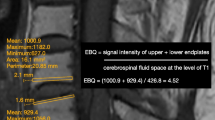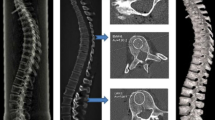Abstract
Purpose
Intervertebral device subsidence is one of the complications of anterior cervical discectomy and fusion. The biomechanical properties of vertebral bony endplate may be related to device subsidence. The aim of this study is to measure the cervical endplate bone density distribution using a novel 3D measurement method.
Methods
Eight human cadaver cervical spines were obtained and levels C3-C7 were dissected and CT scanned. Three-dimensional (3D) CT model was created with the same 3D coordinates of the original DICOM dataset. The regional strength and stiffness of the endplate were determined by indentation testing. The indentation points were recorded by a photograph and the location of the indentation points was projected to the 3D CT model. Three-dimensional coordinates of the indentation point was obtained in the 3D space determined by the DICOM dataset. The area underneath the indentation point was calculated by a trilinear interpolation method directly. Data in HU and correlations with the indentation strength and stiffness were analysed.
Results
A positive correlation was found between HU and strength (r = 0.52) and between HU and stiffness (r = 0.41). Overall, mechanical strength and stiffness and HU in the superior endplate of the caudal vertebra were lower than those in the inferior endplate of the cranial vertebra in the same intervertebral disc.
Conclusions
The mechanical properties and the HU were found to be significantly correlated, which employed a novel 3D HU measurement method, thus demonstrating potential to predict cervical endplate failure risk in a clinical setting.






Similar content being viewed by others
Availability of data and material
The datasets during and/or analysed during the current study available from the corresponding author on reasonable request.
Abbreviations
- ACDF:
-
Anterior cervical discectomy and fusion
- IVD:
-
Intervertebral disc
- DEXA:
-
Dual energy x-ray absorptiometry
- 3D:
-
Three dimensional
- HU:
-
Hounsfield Units
- ROI:
-
Range of interest
- BMD:
-
Bone mineral density
References
Watanabe S, Inoue N, Yamaguchi T, Hirano Y, Espinoza Orias AA, Nishida S, Hirose Y, Mizuno J (2012) Three-dimensional kinematic analysis of the cervical spine after anterior cervical decompression and fusion at an adjacent level: a preliminary report. Eur Spine J 21:946–955. https://doi.org/10.1007/s00586-011-2090-1
Park JY, Choi KY, Moon BJ, Hur H, Jang JW, Lee JK (2016) Subsidence after single-level anterior cervical fusion with a stand-alone cage. J Clin Neurosci 33:83–88. https://doi.org/10.1016/j.jocn.2016.01.042
Tome-Bermejo F, Morales-Valencia JA, Moreno-Perez J, Marfil-Perez J, Diaz-Dominguez E, Pinera AR, Alvarez L (2017) Degenerative cervical disc disease: long-term changes in sagittal alignment and their clinical implications after cervical interbody fusion cage subsidence: a prospective study with standalone lordotic tantalum cages. Clin Spine Surg 30:E648-e655. https://doi.org/10.1097/bsd.0000000000000293
Igarashi H, Hoshino M, Omori K, Matsuzaki H, Nemoto Y, Tsuruta T, Yamasaki K (2019) Factors influencing interbody cage subsidence following anterior cervical discectomy and fusion. Clin Spine Surg 32:297–302. https://doi.org/10.1097/BSD.0000000000000843
Veeravagu A, Cole T, Jiang B, Ratliff JK (2014) Revision rates and complication incidence in single- and multilevel anterior cervical discectomy and fusion procedures: an administrative database study. Spine J 14:1125–1131. https://doi.org/10.1016/j.spinee.2013.07.474
Mende KC, Eicker SO, Weber F (2018) Cage deviation in the subaxial cervical spine in relation to implant position in the sagittal plane. Neurosurg Rev 41:267–274. https://doi.org/10.1007/s10143-017-0850-z
Ordway NR, Lu YM, Zhang X, Cheng CC, Fang H, Fayyazi AH (2007) Correlation of cervical endplate strength with CT measured subchondral bone density. Eur Spine J 16:2104–2109. https://doi.org/10.1007/s00586-007-0482-z
Nguyen C, Poiraudeau S, Rannou F (2012) Vertebral subchondral bone. Osteoporos Int 23(Suppl 8):S857-860. https://doi.org/10.1007/s00198-012-2164-x
Ordway NR, Lu YM, Zhang X, Cheng CC, Fang H, Fayyazi AH (2007) Structural property distribution of the cervical endplate and the correlation with CT measured subchondral bone density. Eur Spine J 16:2110. https://doi.org/10.1007/s00586-007-0505-9
Muller-Gerbl M, Weisser S, Linsenmeier U (2008) The distribution of mineral density in the cervical vertebral endplates. Eur Spine J 17:432–438. https://doi.org/10.1007/s00586-008-0601-5
Lim TH, Kwon H, Jeon CH, Kim JG, Sokolowski M, Natarajan R, An HS, Andersson GB (2001) Effect of endplate conditions and bone mineral density on the compressive strength of the graft-endplate interface in anterior cervical spine fusion. Spine(Phila Pa 1976) 26:951–956. https://doi.org/10.1097/00007632-200104150-00021
Bailey CS, Sjovold SG, Dvorak MF, Fisher CG, Oxland TR (2011) The strength profile of the thoracolumbar endplate reflects the sagittal contours of the spine. Spine(Phila Pa 1976) 36:124–128. https://doi.org/10.1097/BRS.0b013e3181cc8a32
Kishimoto M, Akeda K, Sudo A, Espinoza Orias AA, Inoue N (2016) In vivo measurement of vertebral endplate surface area along the whole-spine. J Orthop Res 34:1418–1430. https://doi.org/10.1002/jor.23354
Chahla J, Liu JN, Manderle B, Beletsky A, Cabarcas B, Gowd A, Inoue N, Chubinskaya S, Trenhaile S, Forsythe B, Cole B, Verma N (2019) Bony ingrowth of coil-type open architecture anchors compared with screw-type PEEK anchors for the medial row in rotator cuff repair. Arthroscopy, A Randomized Controlled Trial. https://doi.org/10.1016/j.arthro.2019.11.119
Cheng CC, Ordway NR, Zhang X, Lu YM, Fang H, Fayyazi AH (2007) Loss of cervical endplate integrity following minimal surface preparation. Spine(Phila Pa 1976) 32:1852–1855. https://doi.org/10.1097/BRS.0b013e31811ece5a
Brenke C, Dostal M, Scharf J, Weiss C, Schmieder K, Barth M (2015) Influence of cervical bone mineral density on cage subsidence in patients following stand-alone anterior cervical discectomy and fusion. Eur Spine J 24:2832–2840. https://doi.org/10.1007/s00586-014-3725-9
Panjabi MM, Chen NC, Shin EK, Wang JL (2001) The cortical shell architecture of human cervical vertebral bodies. Spine(Phila Pa 1976) 26:2478–2484. https://doi.org/10.1097/00007632-200111150-00016
Lim S, Joung H, Shin CS, Lee HK, Kim KS, Shin EK, Kim HY, Lim MK, Cho SI (2004) Body composition changes with age have gender-specific impacts on bone mineral density. Bone 35:792–798. https://doi.org/10.1016/j.bone.2004.05.016
Feng H, Li H, Ba Z, Chen Z, Li X, Wu D (2019) Morphometry evaluations of cervical osseous endplates based on three dimensional reconstructions. Int Orthop 43:1521–1528. https://doi.org/10.1007/s00264-018-4053-1
Muller-Gerbl M, Putz R, Hodapp N, Schulte E, Wimmer B (1989) Computed tomography-osteoabsorptiometry for assessing the density distribution of subchondral bone as a measure of long-term mechanical adaptation in individual joints. Skeletal Radiol 18:507–512. https://doi.org/10.1007/bf00351749
Muller-Gerbl M, Putz R, Kenn R (1992) Demonstration of subchondral bone density patterns by three-dimensional CT osteoabsorptiometry as a noninvasive method for in vivo assessment of individual long-term stresses in joints. J Bone Miner Res 7(Suppl 2):S411-418. https://doi.org/10.1002/jbmr.5650071409
Acknowledgements
I would like to thank for Dr Hidetoshi Nojiri and Sayuri Kitahata for advice on experiments.
Funding
This study was supported by research funding from Orthopedic Biomechanics Fund at Rush University Medical Center for costs of cadaveric specimens. The funding source had no role in the study design, data collection or interpretation of results. There was no additional external funding received for this study.
Author information
Authors and Affiliations
Contributions
Alejandro A. EspinozaOrı ́as involved in data curation. Alejandro A. EspinozaOrı ́as participated in formal analysis. Takeshi Hara, Yukoh Ohara, Kaosu Takami, Eiji Abe involved in investigation. Nozomu Inoue involved in methodology. Nozomu Inoue participated in project administration. Nozomu Inoue participated in software. Nozomu Inoue and Hajime Arai supervised the study. Takeshi Hara involved in writing—original draft. Nozomu Inoue involved in writing—review&editing.
Corresponding author
Ethics declarations
Conflicts of interest
No potential conflicts of interest are disclosed.
Ethics approval
This study was approved by the Rush University ethical committee.
Additional information
Publisher's Note
Springer Nature remains neutral with regard to jurisdictional claims in published maps and institutional affiliations.
Rights and permissions
About this article
Cite this article
Hara, T., Ohara, Y., Abe, E. et al. Cervical endplate bone density distribution measured by CT osteoabsorptiometry and direct comparison with mechanical properties of the endplate. Eur Spine J 30, 2557–2564 (2021). https://doi.org/10.1007/s00586-021-06920-2
Received:
Revised:
Accepted:
Published:
Issue Date:
DOI: https://doi.org/10.1007/s00586-021-06920-2




